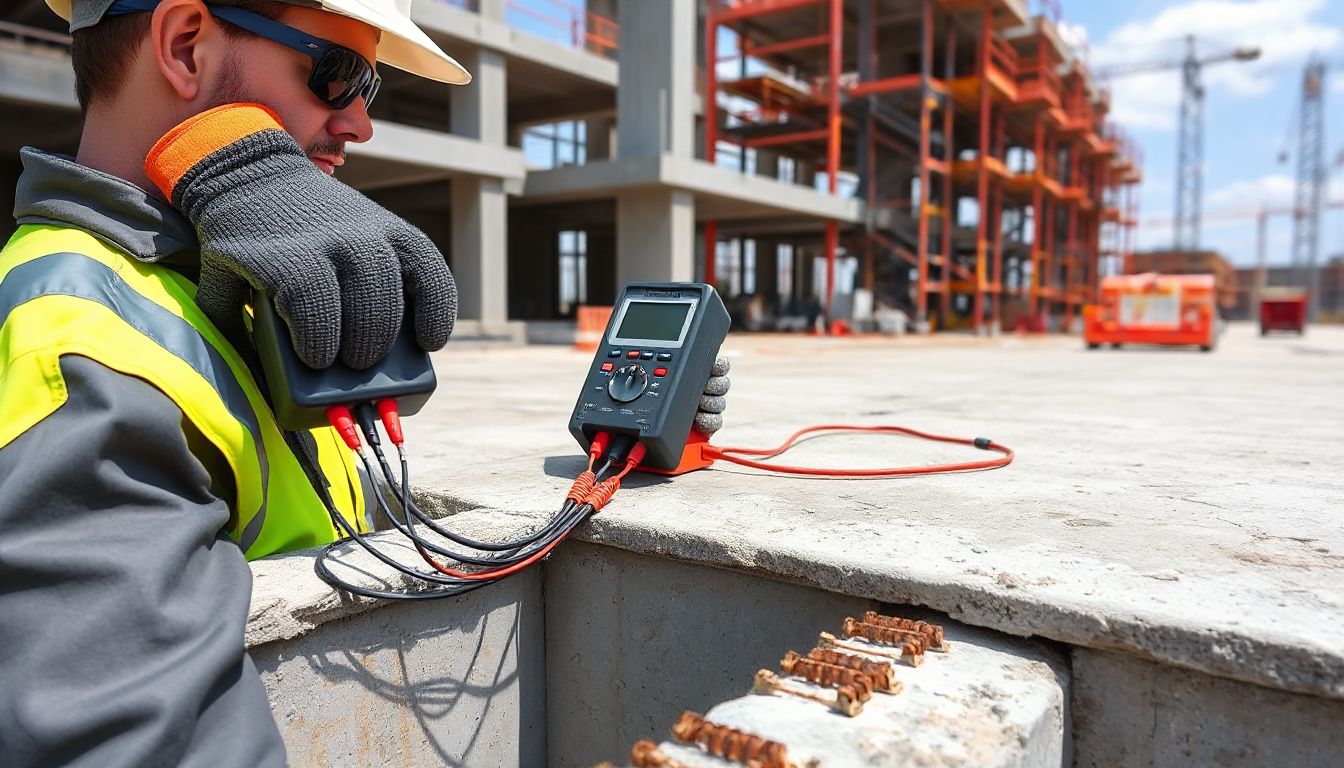
Introduction
Corrosion in reinforced concrete is a sneaky problem. It slowly weakens structures, leading to cracks, spalling, or even full failure. Fixing these issues costs a lot and can be dangerous. Catching corrosion early can save money and keep people safe. That’s where the half-cell potential test comes in. It’s a simple, non-invasive way to spot corrosion before it causes serious damage.
Understanding Corrosion in Reinforced Concrete
Causes and Mechanisms of Reinforcement Corrosion
Corrosion happens when moisture, oxygen, and certain chemicals meet the steel inside concrete. Chloride ions from de-icing salts or seawater often cause this. Carbonation, a natural process where carbon dioxide makes the concrete more acidic, also damages the protective layer around rebar. When these factors combine, they create an electrochemical reaction that eats away at steel.
Consequences of Corrosion on Structural Integrity
Once reinforcement starts to rust, concrete can crack and fall apart. Repair costs shoot up into thousands or even millions of dollars. Worse, weakened structures may fail unexpectedly, risking lives. For example, a bridge collapse or a building facade falling off could happen if corrosion isn’t checked.
Need for Precise Corrosion Mapping
Visual inspections don’t give a clear picture of internal corrosion. Sometimes, the concrete looks fine but hidden damage is extensive. Advanced tools like the half-cell potential test help engineers find problem areas accurately. Targeted repairs save time, money, and improve safety.
Principles of Half-Cell Potential Testing
What is Half-Cell Potential Testing?
This test measures the likelihood that steel reinforcement is corroding. It works by applying a small voltage between the steel and a reference electrode outside the concrete. If the metal shows a certain potential, it signals active corrosion. Think of it as a health check for concrete’s “heart”—the steel inside.
Equipment and Setup
To perform this test, you need a reference electrode (like a copper/copper sulfate electrode), a multimeter, and a portable device. Before testing, clean the concrete surface, removing dirt, oil, or loose material. Proper setup ensures accurate readings.
Interpreting Half-Cell Potential Data
Results are shown as voltages:
- Less than -350 mV usually means active corrosion.
- Between -200 and -350 mV suggests possible corrosion.
- Above -200 mV generally indicates low or no corrosion.
Using charts helps you quickly understand risks. But keep in mind, environmental factors like moisture and temperature can affect measurements.
Conducting a Half-Cell Potential Test
Pre-Test Preparation
Start by cleaning the surface thoroughly. Moisture levels affect results, so it’s best to test in dry conditions or consistent humidity. Safety gear is essential as you work around construction sites or elevated surfaces. Plan your access points beforehand.
Step-by-Step Testing Procedure
- Mark a grid on the concrete surface for systematic mapping.
- Attach the reference electrode securely to different points.
- Connect the electrode to your device.
- Take voltage readings at each point, recording data carefully.
- Cover the entire area in a logical pattern for complete corrosion mapping.
- Repeat measurements for accuracy, especially if conditions change.
Best Practices for Reliable Results
Always calibrate your equipment before use. Check environmental conditions—humidity and temperature can influence results. Use consistent pressure on electrodes for uniform contact. Multiple readings in each spot help verify consistency and accuracy.
Corrosion Mapping and Data Analysis
Creating Corrosion Probability Maps
Input your data into mapping software or draw manually to create visual maps of potential readings. Overlay these with structural drawings. Areas with low potentials appear as red zones—high risk—while safer areas show as green or blue.
Identifying Critical Areas for Intervention
Focus repairs on red zones that indicate high corrosion activity. Moderate zones may need monitoring or minor fixes. Low-risk areas require no immediate action. Combining half-cell potential data with other non-destructive tests, like resistivity or ultrasound, yields a complete picture.
Case Studies and Industry Applications
In recent projects, engineers used the half-cell potential map to successfully target corrosion repair on bridge decks and parking garages. These maps guided precise interventions, extending the life of the structures. Industry standards from groups like RILEM or ACI offer guidelines to ensure proper testing and interpretation.
Actionable Strategies Based on Test Results
Maintaining and Monitoring Structures
Use potential maps to plan regular inspections. Re-testing after repairs confirms successful mitigation. A schedule prevents surprises and keeps structures safe.
Implementing Remediation Measures
When active corrosion is detected, options include cathodic protection systems, protective coatings, or replacing severely damaged reinforcement. Structural reinforcement or even full replacement may be necessary in extreme cases.
Enhancing Long-Term Durability
Choose durable materials and protective coatings during construction. Regular maintenance and continuous monitoring, including embedded sensors or periodic half-cell tests, keep future repairs manageable and costs low.
Conclusion
Half-cell potential testing is a powerful tool in the fight against corrosion. It helps engineers pinpoint trouble spots without damaging the concrete. Proper testing, mapping, and analysis lead to smarter maintenance and safer structures. Incorporating this technique into regular inspections can save big—both in dollars and safety.
Act now—schedule corrosion mapping for your infrastructure and stay ahead of costly repairs. Protect your assets, extend their lifespan, and ensure safety for years to come.